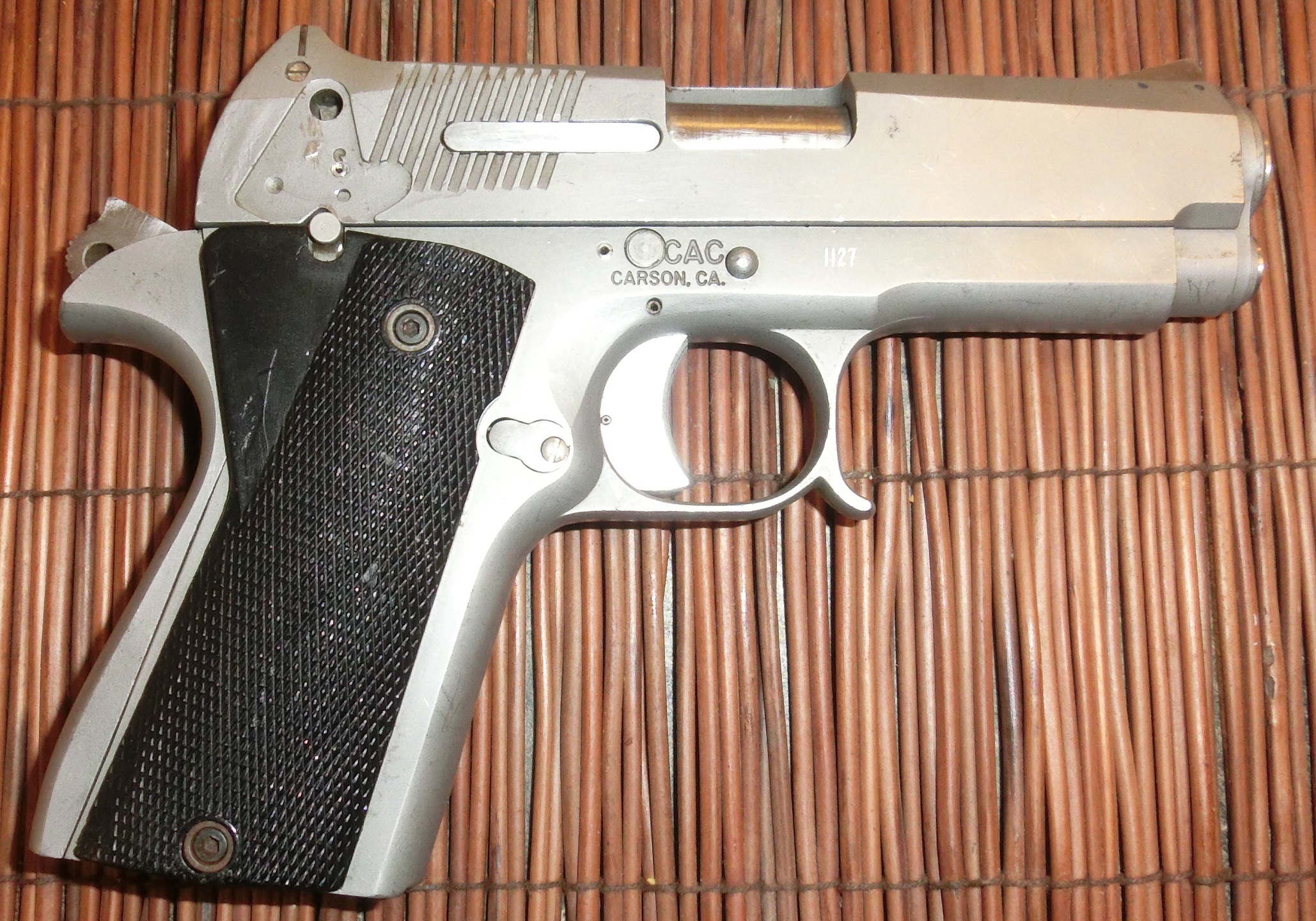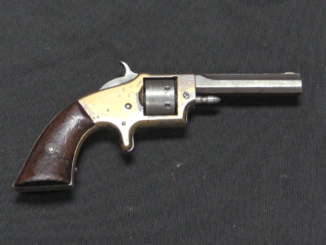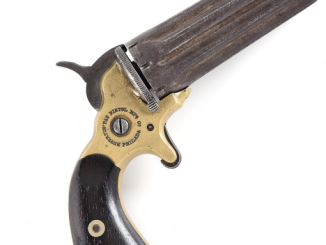Samuel Colt disliked the idea of a double action revolver, considering the idea to be wasteful of ammunition and likely to be fragile. However, he passed away in 1862, and by 1873 double action Webley (and other British make) pocket revolvers were starting to become popular in the United States. In order to compete with them, the Colt company decided to introduce its own first double action model. Designed by talented Colt engineer William Mason, the Model 1877 was released in three calibers, .32 (the Rainmaker), .38 (the Lightning), and .41 (the Thunderer). Only a few hundred of the .32 models were made, but the Lightning and Thunderer were quite successful, with 166,849 made between 1877 and 1909. Both calibers were offered as 6-shot guns on identical frames. Barrels could be had form 1.5 inches up to 10 inches, with or without ejectors, and with a variety of finish levels including a few very fancy engraved examples like the one we have here today.
Related Articles

Semiauto pistol



How awful was the DA trigger pull?
Awful. Granted, I was 15 when my dad sold his, but I remember thinking at the time, “why bother.” But if you were an 1880s man accustomed to shoeing mules barehanded, it was probably just fine.
I’m your huckleberry.
Had to be done.
Both self-cocking (now called DAO) and true double-action (DA) revolvers were known in the US as early as the Civil War, both in the form of Birmingham-made guns with Tranter double triggers and Adams revolvers. (There is a published photograph of Gen. Custer in camp, c.1870?, in possession of an Adams.) Of course the unsuccessful Starr and Savage revolvers were types of DA. If Webley Bulldogs were flooding the US market sufficiently to alarm Colt, starting from UK introduction in 1972 to do so, I am quite surprised. Though I now find out that when President Garfield was assassinated in 1881, the murder weapon was a Webley Bulldog.
There was also the J.M. Cooper double-action copy of the Colt 1849 Pocket Model;
https://simpsonltd.com/j-m-cooper-pocket-model-revolver/
Copies of the Adams revolvers in .31 and .36 were made under license by the Massachusetts Arms Company beginning in 1859;
https://collegehillarsenal.com/mass-arms-36-adams-revolver-very-fine
When you factor in the Remington-Rider patent DA revolvers, ranging from the Pocket Model on up to modified 1858.36 Navy and .44 Army types in both percussion and metallic cartridge conversion form, Colt and Smith and Wesson were definitely “behind the curve” in introducing double-action service and personal defense revolvers.
cheers
eon
No, the Garfield gun was American made. F&W IIRC.
I’ve heard varying accounts of the provenance of Guiteau’s revolver; since it’s now lost, we may never know for certain. In the transcript of Guiteau’s cross-examination, the prosecution refers to it as “that British bull-dog pistol”, whether that refers to its manufacture or merely a general type is unclear. The association between the Bulldog and Guiteau was widespread enough that the weapon is so labeled in this ‘Puck’ cover of July 1881 caricaturing the assassin, an image I first saw in a history book as a small child which has stuck in my memory ever since.
https://upload.wikimedia.org/wikipedia/commons/7/70/Guiteau_cartoon2.jpg
If it helps, the term “Bull-Dog” was often used as a marketing name because the single word “Bulldog” without the hyphen was a licensed trademark of Webley’s.
So Guiteau’s revolver was most likely a copy, made in the U.S. or elsewhere.
As related in Assassination in America by James McKinley, Guiteau bought the .44 caliber revolver from a pawnshop, along with a pocketknife, for $10.
According to Cartridges of the World (6th and 13th eds.), the .44 Bull Dog cartridge was new at the time, having been introduced in 1879-80. It was made in both black powder and smokeless powder loadings, and normally had a 168 to 170 grain RNL bullet with a muzzle velocity of 460 F/S and a muzzle energy of 80 FPE.
According to testimony, Guiteau, who knew little or nothing of firearms, purchased it because the pawnbroker told him it “would kill a horse”.
Of course, he shot Garfield on the grounds that he wanted to be ambassador to Chile’, too. Nobody knows why.
cheers
eon
“(…)varying accounts of the provenance of Guiteau’s revolver; since it’s now lost, we may never know for certain(…)”
Although current whereabouts of weapon itself are unknown, Smithsonian apparently is in possession of photograph of said weapon. See:
https://www.thevintagenews.com/2017/04/08/the-killer-of-president-garfield-used-a-gun-with-an-ivory-grip-it-would-look-good-in-a-museum-after-i-had-killed-him/
Can anybody said it is genuine British weapon or some copy using photo available above?
“According to testimony, Guiteau, who knew little or nothing of firearms, purchased it because the pawnbroker told him it “would kill a horse”.”
Article above claim he choose one with ivory grips because it would look good in a museum after I had killed him
released in three calibers, .32 (the Rainmaker), .38 (the Lightning), and .41 (the Thunderer). Only a few hundred of the .32 models were made, but the Lightning and Thunderer were quite successful, with 166,849 made between 1877 and 1909.
Wait… this does overlap with another Colt weapon named Lightning – namely pump-action long-arm: https://en.wikipedia.org/wiki/Colt_Lightning_Carbine
which was made 1884…1904.
Was this name collision intentional? Was it supposed to somehow boost sales?
The Lightning rifle was so named by the Colt factory. The names for the revolvers were the idea of Benjamin Kittredge & Co. of Cincinnati, Ohio, the wholesale jobber which distributed Colt products outside of the northeastern U.S. at the time.
cheers
eon
We’ll just have to see if the ads prove your idea correct!
IIRC The official nomenclature for this model was the the model of 1877. Colt didn’t refer to them as Lightning, Thunderer or Rainmaker. Just as Colt didn’t actually name the model 1873 as Peacemaker etc.
The Thunderer was Billy The Kid’s choice of revolver (circa 1878).
The Webley RIC was introduced in 1867 or 1868. A medium to full-size revolver chambered for fairly serious cartridges. Reportedly (though debated), Custer had a pair at Little Big Horn.
The smaller Bullbog followed in the early 1870s. (The cheap but hugely popular Belgian copies arrived in the late 1870s, in huge numbers and at low cost.)
Both were by contemporary standards excellent revolvers. In many ways (sorry, Americans) the RIC was a better social gun than the Colt 1873.
I think that explains why Colt went DA so soon after introducing the SAA. Not so much that the Webley was a real commercial threat, but that it showed the emerging way ahead and Colt wanted to catch up.
“Samuel Colt disliked the idea of a double action revolver…”(C)
Probably, one should not confuse fables for newsmen with the true reason.
Colt’s production was predominantly machine-made. A double-action revolver requires the use of a significant proportion of manual labor, which significantly increases their cost.
But, in the end, he had to.
P.S. Nice revolver.
And the video is good.